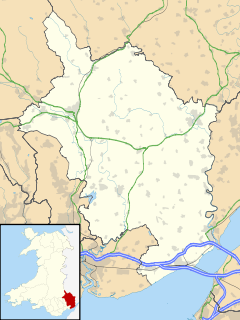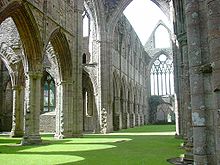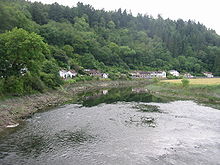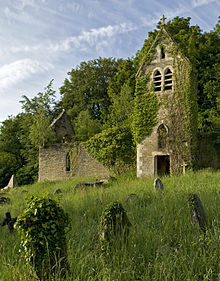- Tintern
-
Coordinates: 51°41′48″N 2°40′53″W / 51.69677°N 2.68142°W
Tintern Welsh: Tyndyrn 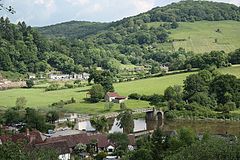
Tintern, viewed from the south.
 Tintern shown within Monmouthshire
Tintern shown within MonmouthshireOS grid reference SO530000 Principal area Monmouthshire Ceremonial county Gwent Country Wales Sovereign state United Kingdom Post town CHEPSTOW Postcode district NP16 Dialling code 01291 Police Gwent Fire South Wales Ambulance Welsh EU Parliament Wales UK Parliament Monmouth Welsh Assembly Monmouth List of places: UK • Wales • Monmouthshire Tintern (Welsh: Tyndyrn) is a village on the west bank of the River Wye in Monmouthshire, Wales, close to the border with England, about 5 miles north of Chepstow. It is popular with tourists, who visit for the natural scenery and the ruined Tintern Abbey.
The modern settlement of Tintern has been formed through the coalescence of two historic villages, previously separate parishes - Tintern Parva, forming the northern end of the village and Chapel Hill which forms the southern end. The village is designated as a Conservation Area.[1]
Contents
History
Early history
A ford across the navigable and tidal River Wye was in use in Roman times, close to the site of the abbey. After the withdrawal of the Romans from Wales, the kingdom of Gwent emerged, and, according to tradition, in the 6th century one of their kings, Tewdrig, came out of retirement as a Tintern hermit to defeat the invading Saxons in battle, perhaps at a site known today as Pont y Saison (Bridge of the Saxons) in the Angiddy Valley.[2] The name Tintern may derive from the Welsh din + d/teyrn, meaning "rocks of the king".[3]
The abbey
Tintern Abbey was founded beside the river by Walter de Clare on May 9, 1131, during the reign of King Henry I. It was the second Cistercian foundation in Britain, and its monks came from a daughter house of Cîteaux in France.
The present-day remains at Tintern are a mixture of building works covering several centuries. Between 1270 and 1301 the abbey was rebuilt, and when it was completed around four hundred monks lived in the complex. The abbey's land was divided into agricultural units or granges, and local people provided farm labour and served the abbey and its many visitors. For 400 years, it dominated the economy of its surrounding area. During some of this period the area was contested between the Welsh and English, the closest battle being won in 1404 by Owain Glyndwr, at Craig y Dorth near Monmouth. The area also had to contend with the Black Death, and it is suspected that the neighbouring village of Penterry disappeared at that time. The abbey remained in operation until the Dissolution of the Monasteries in 1536.
Brass, iron and wire works
Though it has been suggested that the monks or lay brethren of Tintern Abbey exploited the woodlands and river power for operating iron forges, evidence of this is lacking. Industrial activity began in 1568 when the newly established Company of Mineral and Battery Works built wireworks. It is possible that brass was made,[4] but the works mainly made iron wire. This was used for a wide variety of industries with essential goods: cards for the woollen industry, nails, pins, knitting needles and fish hooks. The site was convenient, because the Wye offered transportation, the Angiddy stream water power, trees in nearby woods charcoal fuel and a ready supply of minerals in the locality. The company began letting their works. Farmers of the works in the 17th century included Sir Basil Brooke, Thomas Foley, the important ironmaster and his son Thomas Foley.[5] A blast furnace and forges were built in the valley in the 17th century and operated with the wireworks until the end of the 18th century.[6]
For 300 years, the numerous works and forges along the Angiddy Valley dominated the village and surrounding communities. A branch railway line connecting the works with the Wye Valley Railway by way of a bridge was completed in 1875, but by then the works for which it was built had gone out of business. All the works had closed by 1880, but several associated ponds, leats and culverts still remain visible.[2][7] After being used in the early 20th century as a horse-drawn tramway, the bridge now carries a footpath.[8] Tintern railway station, which was along the Wye Valley Railway was a few minutes walk from the village.[9]
The tourist industry
By the late 18th century, tourism had started in the Wye Valley, with many visitors travelling on the river to see the abbey and other "picturesque" sites in the area. William Wordsworth stayed in the village in 1798 and wrote Lines composed a few miles above Tintern Abbey.[10] The completion of the new turnpike road (now the A466) in the valley in 1822, and the arrival of the Wye Valley Railway in the 1870s,[11] greatly increased the number of visitors, and tourism became the main stay of Tintern's economy and remains so today.[12]
Areas of interest
Walks
Tintern is home to several different walking trails, in addition to notable areas of interest. A bridge a little to the north of the abbey crosses the River Wye, and is open to the public on a yearly basis. The bridge leads to a choice of several clearly marked walking paths, most notably a path to "Devil's Pulpit" and a path to Offa's Dyke. Devil's Pulpit is a small rocky outcrop that overlooks the abbey. According to local legend, the Devil used to preach from the outcrop and attempt to seduce the abbey's monks away from Christianity.
St Mary the Virgin on Chapel Hill
The ruins of St. Mary's Church can also be seen on a hill to the east of the abbey. Medieval in origin, the church was virtually rebuilt in 1866-68 by John Prichard.[13] While much of the church is still clearly visible today, a fire in 1977 left the building in ruins. The churchyard is now maintained by volunteers .[14]
Water Mill
A disused water-driven mill lies a little to the south of the abbey. Visitor information and shops can be found close by. The village also boasts an award-winning vineyard.
The public house, The Moon and Sixpence, was originally known as the Mason's Arms, but changed its name in 1948 following a visit by Somerset Maugham, author of the 1919 novel of the same name.[15]
The name Tintern has been given to a type of blended cheese made by Abergavenny Fine Foods, which is seasoned with shallots and chives and covered with a distinctive bright green wax.
Tintern Girls Grammar School, a private school in Melbourne, Australia, was named after the abbey.
References
- ^ Adopted Unitary Development Plan
- ^ a b The Tintern Village Website
- ^ E. T. Davies, A History of the Parish of Mathern, 1990
- ^ Photo of plaque commemorating brass works
- ^ W. Rees, Industry Before the Industrial Revolution.
- ^ P. Riden, A gazetteer of charcoal-fired blast furnaces (Merton Priory Press, Cardiff 1993), 48-51.
- ^ http://www.monmouthshire.gov.uk/NR/rdonlyres/642F4FB5-FB98-4D79-B0D5-595810D70D87/0/LANDMAPVolume5CulturalAspectTA13MB.pdf
- ^ Alan Crow, Bridges on the River Wye, 1995, ISBN 0-9518589-9-8
- ^ B. M. Handley and R. Dingwall, The Wye Valley Railway and the Coleford Branch, 1982, ISBN 0-85361-530-6
- ^ The Tintern Village Website
- ^ Photo of former railway bridge
- ^ Photo of Abbey Mill tourist shop
- ^ "CHAPEL HILL, St. Mary (1863-1868) Monmouthshire". ICBS Archive of Church Plans. The Incorporated Church Building Society. http://www.churchplansonline.org/retrieve_results.asp?search_args=x%3DTINTERN+PARVA%7Cl%3DCHAPEL+HILL. Retrieved 25 May 2011.
- ^ The Tintern Village Website
- ^ Ivor Waters, Inns and Taverns of Chepstow and the Lower Wye Valley, 1975, ISBN 0 900278 28 5
External links
Categories:- Villages in Monmouthshire
- River Wye
Wikimedia Foundation. 2010.

